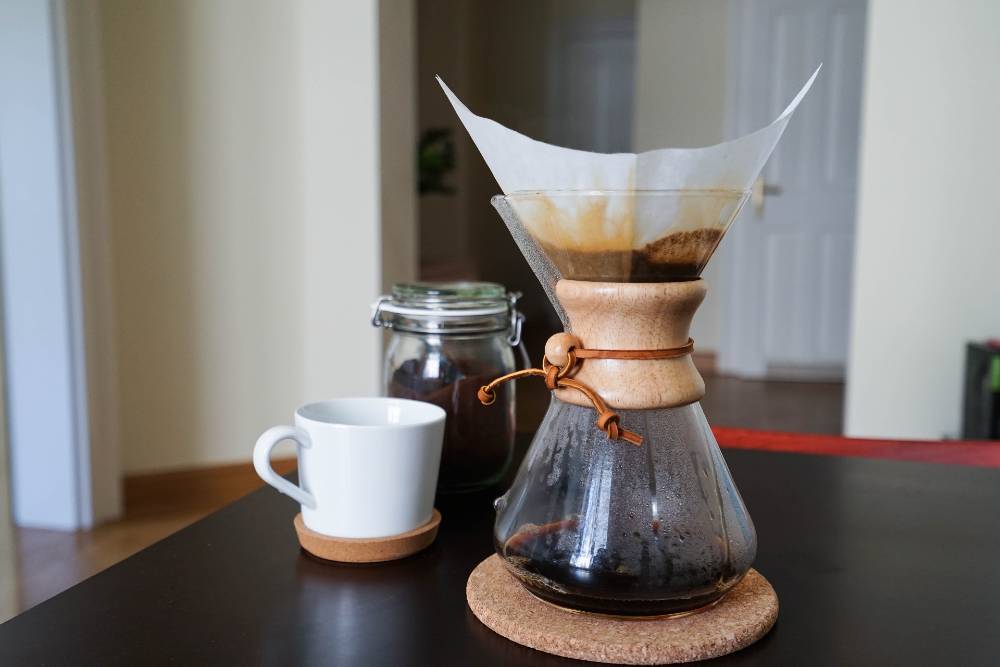It may seem hard to believe that the thick, dark, delicious cup of coffee you’re tucking into is not a man-made invention. The coffee bean actually comes from a species of plant and it experiences a long journey to get from the growing on the plantation to ending up as your morning brew. If you’ve ever stopped to wonder, what actually is a coffee plant? and how is coffee harvested? then this article is for you!
Coffee is harvested from coffea plant once it has matured at around 4 years old. The beans are found encased in a cherry-like fruit and are actually the seeds of the plant. The coffee fruit is harvested by hand or by machine and undergoes a long processing procedure before it ends up as your delicious cup of java.

Background of the Coffee Plant
The coffee plant is actually a small tree or shrub like species that is native to tropical parts of Africa and Asia. The plant is grown from the coffee seeds which are just un-processed coffee beans.
When the conditions are right, the plant takes between three and four years to mature and then it starts to produce flowers. Similar to a cherry tree the flowers mature into a dark red fruit after about 8 months. This coffee cherry contains a hard seed in the centre, otherwise known as your coffee bean!
Most coffee plants yield one harvest per year but, in certain cases, two harvests can be produced, utilising a secondary crop.
So from the seed to the first coffee crop we can be looking at around 4 – 5 years of growth already, before we even start the harvest!
How Is Coffee Harvested?
Selective Hand Picking
This is by far the slowest and most labor intensive harvest method. Individual pickers will examine the coffee berries and physically select the ones that are a deep red color as opposed to the un-ripe green ones.
The pickers will rotate between the trees, selecting only the ripest fruit and slowly filling their baskets as they go. They usually get paid by the basketful and experienced pickers may yield 6-7 baskets a day.
Due to the ongoing ripening of the fruit it can take workers 8-10 days to fully harvest all the beans.
This method is time consuming and expensive but the result is a highly selective batch. The riper the fruit, the more aromatic oil the bean contains and less sour acids are present. This method is common for finer arabica coffee beans.
Stripping By Hand
This method is where all the beans are harvested, no matter how ripe they are. It’s a lot faster than selective hand picking and less labourers are required.
The process works by laying out sheets of canvas on the ground surrounding the coffee tree. Then they shake and pull on the plant to dislodge the beans. The fruits cascade from the plants and tumble onto the canvas where they can be easily transferred to bags for weighing.
The time taken to gather the beans is far less using this method and the weight of beans collected is much greater. The downside is that we lose the selectivity of hand picking and many unripe beans will make their way into the mix. This method can successfully gather the full crop in less time but the quality of the coffee bean may suffer.
Mechanical Stripping
This method is very similar to hand stripping as mentioned above. The coffee pickers lay out canvas sheets on the ground to catch the fruit but instead of shaking they use a specially designed instrument.
Like a cross between a wide toothed comb and a garden rake, this hand-held, mechanised tool (called derricadeiras) efficiently strips the beans from the branches to be gathered on the canvas sheets.
Similar to hand stripping, the time taken for harvesting the beans is greatly reduced but all beans, no matter if they’re green or red end up in the pot!
Machine Harvesting
As with most areas of modern farming these days, machines have been developed to carry out the coffee picking task.
Mechanical harvesters are like specialised combines and they utilise a device that taps the fruits into a collection area. The machine vibrates and rotates at variable settings which allows some selectivity when it comes to ripeness.
This method is a good compromise in cost effectiveness as the labour force needed is almost completely diminished but the downside is a machine will always struggle to replace the human eye that can rapidly scrutinise each bean and only collect the ripest.
How Is Coffee Processed?
Once the coffee fruits are harvested the next essential step is to process it to produce the coffee bean.
Wet
The most common procedure is the wet process. This is where the fruit is removed from the bean and is done by fermentation and mechanically.
It is called the wet process because prior to removing the fruit the coffee is sorted by immersion in water. The unripe or bad fruit floats to the surface so can be removed early in the processing chain. Sieves are also used to remove any debris that remains from the harvesting process.
Next the coffee cherries are pressed through a pulping machine. This squeezes the fruits between fixed and moving surfaces to rub away the fruit and yield the bare bean. More water is used to separate the pulpy residue from the beans but inevitably some fruit will still be attached.
To solve this issue the beans are transferred to fermentation tanks where special enzymes are added to digest away the rest of the fruit residue. This process takes 24-36 hours and the beans undergo a thorough rinsing afterwards.
These soggy coffee beans, at this stage, contain about 57% moisture. This needs to be reduced to 10% for the next step. The most common way of drying the beans is by sunlight. The beans are spread out on tables composed of suspended sheets of material or concrete patio areas and are manually turned every 6 hours to allow them to dry evenly.
If the environment is too humid for sun drying the beans can suffer from mildew. In certain cases special drying chambers are utilized to avoid this.
The drying process normally takes about 8-10 days and the resultant bean is referred to as parchment coffee. The beans can then be sorted according to quality and stored ready for export or the next step in processing.
Dry
The dry process uses the whole cherry rather than removing it. The beans are sorted by winnowing. This is basically a large sieve used to toss the beans by hand to separate them from any debris.
The whole cherries are washed and then spread out in the sun on concrete or matted tables. Similar to the wet process they are regularly turned to prevent mildew but the drying process itself takes a lot longer at up to 4 weeks.
These dried cherries are then stored and hulling is needed to remove the outer layers from the precious bean.
Semi-Dry
The semi-dry process is a bit of a hybrid scheme. There are many ways to achieve this process and each farm tends to have its own speciality.
One method is, once the beans have passed through the pulping machine, instead of being washed to remove the residue, the beans are dried immediately. The mucilage layer remains over the bean and is said to provide a sweeter, full-bodied flavor to the coffee but this method needs a lot of care taken.
The residue is prone to fungal and bacterial infections and the processor may need to turn the beans 2-3 times every hour to ensure safe drying.
Some coffee farms are very particular with regards to the exact amount of mucilage left on the bean. They use special pulping machines and avoid fermentation as this can cause variation in bean flavor.
The drying process is tightly monitored and sometimes referred to as “The Honey Process”. It produces high quality coffee with a distinct sweet flavor.
Coffee Milling
Hulling
Following wet processing the parchment coffee is so called because it has a thin papery skin that needs to be removed.
The dry processed beans similarly need attention as they have layers of dried coffee cherry still adhered.
Hulling is the mechanical removal of the debris from the dry coffee bean. This is done either using a simple millstone or more complex machine that is specially designed to tap away the outer layers.
Polishing
To optimise the appearance of the bean some processes utilize polishing to remove the last of the debris. It uses friction to raise the temperature of the bean and rub away the last outer layer. This change in temperature can affect the taste of the bean so some coffee producers opt not to go for this step.
Bean Sorting
The next important stage for our dried coffee beans is that they need to be sorted out size wise. Also any debris that has made its way into the batch during the drying process has to be removed.
Machines are generally used to carry out this step by either sieving or by blowing air through the beans. The idea is that the heaviest beans will land in a nearby container and the very light or defective ones will blow further away to be discarded.
Finally the beans are sorted by color. This is the best way to assess the quality of the beans but needs to be done by hand. Workers manually sort the defective beans from the good ones and this process can be done twice or even three times to leave only the finest beans as the end product.
Grading
Once the beans are sorted the next step is grading. This is based on many different factors from the farm itself (the altitude, the preparation and picking methods); presence of any imperfections (assessed by sampling) and taste testing the end result.
High end coffee beans producers will normally set their own grading methods as well as the standard procedure to ensure a more consistent quality product.
Storage and Distribution
Coffee is normally stored in woven jute bags. If these are poorly designed then the coffee can be subject to damage by exposure to the elements. The jute bags should allow moisture to escape so the coffee doesn’t end up with moisture damage.The sacks full of coffee beans are usually stacked together on pallets to prevent damp contact.

Silos and vats are sometimes designed for coffee bean storage but these often have poor air circulation so can end up with moisture damage.
The worst culprits for bean degradation are varying or extreme temperatures, too much moisture and bright light. All these factors need to be balanced to ensure optimal preservation of the beans. The green coffee beans, if stored correctly, can last for around 12 months.
The next step is distribution and roasting.
The beans are distributed around the world and the global coffee market is enormous. Coffee roasting is usually carried out by companies before the end product reaches the consumer although it is an option to buy green coffee to roast at home.
Related Reading
Why is Coffee Called Java? (A Historical Relic)
The History of Coffee – A Complete Guide Through Time





